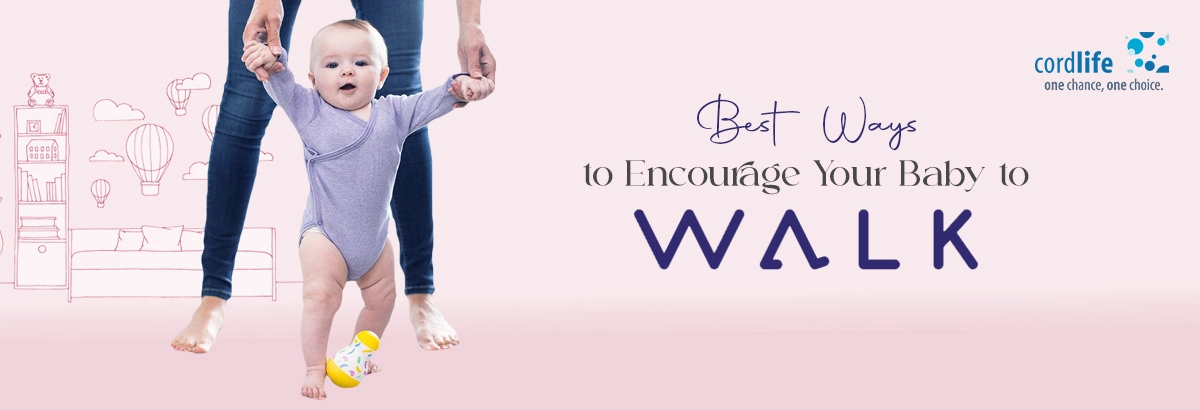Table of Contents
[table_of_contents]
The day your baby smiled their sweet, innocent, gummy smile. What a perfect moment for you! A smile like that made you fall head over heels. You’ll soon find yourself chasing your little cutie amid all the other developmental infant activities. After all, they are ready to take the big plunge – start walking.
According to the American Academy of Paediatrics (AAP), most babies start walking by 1. But not all babies are the same. Your baby may take longer to walk than your friend’s or neighbour’s. So, if between the 9 and 12 months of your baby’s life, you don’t see your baby walking, don’t worry or be scared.
How to Help Your Baby Walk?
You may have to work on your little one’s strengths and address their weaknesses. After all, learning to walk takes time. Although the most effective way to teach your baby to walk is on their own, there are plenty of things to do with your newborn before walking.
Here is a guide for expecting moms to include activities for their newborns before entering the walking zone.
De-clutter the Space Your Baby Will Take
Before anything else, you need to clear up the space your baby will take. Clean the floor, and remove all the showpieces from the top of the cupboard or glass cases in the house. Making your house babyproof will keep the baby safe from harm, and make them feel confident.
Make Them Do the Stool Activity
Bring them a baby-sized stool. Make them sit on it. Ensure that your little one’s feet touch the floor. You can also keep a walking toy at the foot of the stool, and tell your child to get down on their knees and pick it up. Making them sit on a stool emphasises the small legs and helps them build lower body strength.
Make the Baby Walk Along With the Furniture
You’ll notice your child feeling a little scared and wobbling while trying to stand before moving. Encourage them to stand by the side of the furniture – either a sofa, coffee table or TV stand. With furniture by their side, they will feel boosted before walking. Such a newborn activity is known as “cruising.” Your baby will slowly master the art of navigating by moving across the room with the help of the furniture around. You can hold their hand once or twice if they feel imbalanced. Or let them fall once or twice. They may start crying. But encourage them to stand on their feet by clapping your hands, and uttering words like “stand up” or “it’s ok.” If your little one reaches his or her teddy bear or toy car while cruising, more claps for the baby. He or she has done it!
Hold the Little Hands
Make your little one stand right in front of you. Support their upper arms by holding them. Now slowly pull one arm after another. You will notice how smoothly, gently, and naturally those small feet start taking their steps forward.
Choose “push” or “pull” Toys
You can also give your little one push or pull or walking toys to help him walk. With the help of “push” or “pull” toys your baby will confidently explore the world around him. Additionally, these toys offer fun activities to encourage them to squat and reach their aim.
Make the Little One Walk Barefoot
Allow your little one to walk barefoot. You’ll notice their feet may develop a strong grip, and can further improve their coordination and balance by strengthening the muscles. Additionally, they can feel hardwood or grass texture. While getting the feel of the surface their brain adjusts to the muscles and joints of the feet, and this process is known as proprioceptive feedback. Unfortunately, wearing shoes or learning to walk with shoes may slow down the messages the little one’s brain sends to the feet.
Make Them Step Up the Stairs
Maybe walking on the same surface is boring for the little one. Make your child climb stairs with their hands, knees, and feet. In this way, all their body muscles function properly. It strengthens their trunk and leg muscles. Additionally, making them climb stairs keeps the body’s upper and lower functions separate.
Encourage Them to Move Up and Down
Your baby focuses on moving forward just like adults. While taking every step forward the small legs work toward supporting the body and keeping the entire body in balance. Additionally, moving their bodies up and down can get them into a squatting position. Including a few activities, for example, blowing bubbles above their head and making their baby reach for them, or moving the little one’s toys at various heights in their playroom, and making them get those toys from that height, sounds like the little one is slowly taking a squatting position.
You can get a baby walker for your little one. But, keep the walker at a safe distance from the staircase to prevent the little one from falling or getting injured. Nevertheless, as a new mother, you have to keep in mind that using an infant baby walker can miss out on some important milestones like crawling and walking opportunities.
Otherwise, if your little one takes one step at a time, it gives you a chance to celebrate their accomplishments. As a new mom, some of you should know that your little one may or may not start walking early. If you see the little one entering the 18th month, and still not walking, consult your child’s paediatrician immediately.
